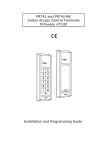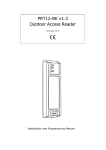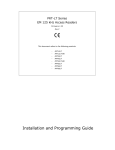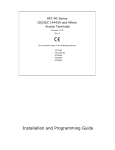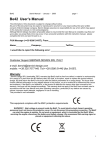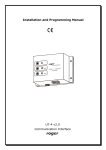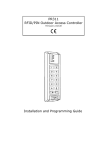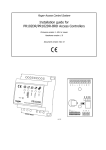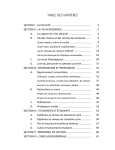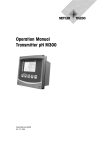Download Installation and Programming Guide PRT62 v1.1 Outdoor Access
Transcript
PRT62 v1.1 Outdoor Access Control Terminal Firmware v74.7 Installation and Programming Guide PRT62 v1.1 fv74 EN Rev.B.DOC 1 TABLE 1 2 3 4 5 6 7 7/6/2007 OF CONTENTS Table of Contents ............................................................................................................................2 General..........................................................................................................................................3 2.1 Designed Function.....................................................................................................................3 2.2 Features ..................................................................................................................................3 Operating Modes .............................................................................................................................4 3.1 Host-controlled Operation (ONLINE Mode)....................................................................................4 3.1.1 Wiegand Data Transmission Format ....................................................................................4 3.1.2 Magstripe Data Transmission Format...................................................................................4 3.1.3 RACS Data Transmission Format.........................................................................................5 3.2 Stand-alone Operation (OFFLINE Mode) .......................................................................................5 3.2.1 Full Stand-alone Operation Mode ........................................................................................5 3.2.2 Simple Stand-alone Mode ..................................................................................................6 Stand-alone Operation .....................................................................................................................6 4.1 Users.......................................................................................................................................6 4.2 ARMED and DISARMED Modes ....................................................................................................6 4.3 Arming and Disarming of the Reader (Reader Rearming) ...............................................................7 4.4 Unlocking Door .........................................................................................................................7 4.5 Alarms.....................................................................................................................................8 4.6 Acoustic and Optical Signals .......................................................................................................9 Programming ................................................................................................................................ 10 5.1 Setting Reader Operating Mode ................................................................................................ 10 5.2 Memory Reset Procedure - Programming MASTER and INSTALLER cards........................................ 11 5.2.1 Factory Default Settings .................................................................................................. 11 5.3 Installer Programming Mode..................................................................................................... 12 5.4 User Programming Mode .......................................................................................................... 13 5.4.1 User Programming Commands ......................................................................................... 13 5.4.2 Programming Examples ................................................................................................... 14 Installation and Setup Guidelines ................................................................................................... 15 Appendix...................................................................................................................................... 15 2 PRT62 v1.1 fv74 EN Rev.B.DOC 7/6/2007 2 GENERAL 2.1 Designed Function The PRT62 terminal has been designed for use in access control installations or systems as an outdoor proximity reader unit to enable user identification via EM 125 kHz UNIQUE standard proximity cards. The PRT62 unit can be configured for stand-alone mode (called OFFLINE mode) or for use with an external Access Control Unit (ACU) supporting compatible data interface formats (ONLINE mode). The PRT62 used in ONLINE mode works as a slave unit with its functions restricted down to reading cards and providing subsequent transmission of such collected data to the host ACU for further processing. The PRT62 terminal has several data transmission formats available for use in ONLINE mode, which include the popular Wiegand and Magstripe (i.e. simulation of output of a magnetic card reader) data protocols. When configured for stand-alone operation (OFFLINE mode), a PRT62 reader independently (i.e. autonomously) controls the supervised door access point. For this mode, it offers two installation options — one of them uses its built-in I/O signal lines as standard general purpose inputs and outputs, the other uses them for communication with an external XM-2 I/O module and a second PRT series reader. An access control installation containing two PRT series readers (one at the entry, the other at the exit side of the supervised door) enables two-way passage control. The system setup utilizing an XM-2 module provides higher level of security for door access control system by separating its logical element (the reader unit) from the actuator element controlling door lock (i.e. the door lock relay). Note: When configured for Full Stand-alone Mode, a PRT62 reader may be used in pair with another PRT series reader. In this setup both readers can provide two-way door control (entry and exit). 2.2 Features Host-controlled mode (ONLINE mode) 26/34/42/66 bit Wiegand data format interfaces Magstripe data format interface (ABA Track II emulation) RACS communication interface (for PR series ACUs from ROGER) LED/BUZZER control input Stand-alone mode (OFFLINE mode) System settings stored in nonvolatile memory Enrollment of up to 120 users User indexing (ID indexed user records) Support for Door Contact (DC) and Request-To-Exit (REX) push button Door Alarm output line Reader Disarmed Output and Ready Input signals for integration with security systems Two-way door control (requires additional PRT reader to form a pair) Uses built-in I/Os or remote XM-2 I/O module 3 PRT62 v1.1 fv74 EN Rev.B.DOC 7/6/2007 3 OPERATING MODES 3.1 Host-controlled Operation (ONLINE Mode) When operated in ONLINE mode, a PRT terminal is controlled by a Access Control Unit (ACU). The terminal reads card code and then transmits the collected data to the ACU for further processing. Each PRT terminal offers the following communication interfaces (data transmission formats): Wiegand 26bit Wiegand 34bit Wiegand 42bit Wiegand 66bit Magstripe (ABA Track II emulation) RACS (Roger) Note: The RACS format indicates communication data interface designed for use with PRxx1/PRxx2 series ACUs from ROGER. 3.1.1 Wiegand Data Transmission Format PRT Series Reader Configured for Wiegand Interface DATA 1 DATA 0 IN1 CLK DTA When employing Wiegand transmission format, the data are transferred using sequences of pulses sent over the CLK and DTA lines. Depending on the selected version of the transmission format, the PRT reader uses 26, 34, 42 or 66 bits to transmit a code read in from the card presented or the PIN code entered. Note: For card codes length longer than the number of bits available in the selected data transmission format, a PRT reader omits the most significant bits of the data transmitted. As a result you may observe that the actual card codes send by the reader differs from the full card code. Wiegand ACU When Wiegand format is used, the dual color LED STATUS indicator lights steady in RED and the LED SYSTEM turns ON for a short while with each reading of a card. The LED OPEN is controlled by the IN1 input line. When IN1 is shorted with the power supply negative lead the LED OPEN turns ON and the internal BUZZER sounds, when IN1 is shorted with the power supply positive terminal or left unconnected the LED OPEN and the BUZZER are not active. 3.1.2 Magstripe Data Transmission Format PRT Series Reader Configured for Magstripe Interface DATA CLOCK IN1 CLK DTA When employing Magstripe transmission format, the data is transferred using electric signal waves transmitted over the CLK and DTA lines. The LED indicators and the buzzer are controlled in the same manner as described for Wiegand formats (see previous section). In the Magstripe format the PRT reader sends entire card or PIN code. Magstripe ACU 4 PRT62 v1.1 fv74 EN Rev.B.DOC 7/6/2007 3.1.3 RACS Data Transmission Format PRT Series Reader Configured for RACS Interface With RACS format, communications between the PRT62 and its host ACU is bidirectional, hence the ACU is capable of monitoring it. Also, the reader’s LEDs and the buzzer are controlled by the host ACU, unless the reader has lost communication with its host. DATA CLOCK IN1 CLK DTA When employing RACS transmission format, the PRT62 unit communicates with its host ACU via the CLK and DTA lines. Unlike in the Wiegand or Magstripe formats, the PRT62 unit using RACS format requires an individual address (ID=0…3) to be set for it during configuration of the reader. PRxx1/PRxx2 Series ACU When RACS format is used, the IN1 input on the PRT62 is not used to control the unit’s LEDs (the host unit handles this), instead, it is dedicated to disable reader’s operation. When IN1 is shorted with the power supply negative lead, the unit does not read cards. Notes: When all LEDs are flashing on the PRT62 reader configured for RACS format it indicate that the unit has lost communication with the host ACU. 3.2 Stand-alone Operation (OFFLINE Mode) The PRT62 reader offer two variants of stand-alone operation: Full Stand-alone Mode and Simple Standalone Mode. In both operation modes the reader is capable of providing independent (i.e. autonomous) control of one door passage. 3.2.1 Full Stand-alone Operation Mode In this mode, the reader’s CLK and DTA lines are used for communication with a remote XM-2 I/O module and, optionally, with an additional (secondary) PRT series reader (for two-way door control). The IN1 line operates as an input and can be configured to various options. The I/O lines on the XM-2 module can be programmed to have several predefined functions (see settings for C5, C6, C7, C8 and C9 parameters in section Installer Programming Mode). The Full Stand-alone Operation Mode offers improved security, because it allows for separating the identification device (i.e. the reader unit) from the actuator element (i.e. the relay operating the electric lock). 12 V Primary PRT Series Reader Configured for Full Stand-alone Mode Secondary PRT Series Reader Configured for RACS Mode Address ID0 CLOCK DATA NO1 COM NC1 NO2 COM NC2 IN1 COM IN2 IN1 CLK DTA IN1 CLK DTA IN / OUT DEVICES XM-2 I/O Expander Module The max. cable length between a PRT reader and an XM-2 module or between a primary and a secondary PRT reader units is limited to 150 m. For two-way door control, the primary PRT unit needs to be configured for Full Stand-alone Mode and the interconnected secondary PRT unit needs to be configured for RACS Mode with its device address set to ID=0. Note: For Full Stand-alone Mode, the XM-2 I/O extension module connected to the PRT reader has to have ID=5 address setting (i.e. jumpers JP1 and JP3 closed). 5 PRT62 v1.1 fv74 EN Rev.B.DOC 7/6/2007 3.2.2 Simple Stand-alone Mode 12 V Input or Output In this mode, the reader’s CLK and DTA lines are used as standard I/O lines and the IN1 line operates as an input. The CLK, DTA and IN1 lines can be configured to have one of the several available functions. Input or Output IN1 CLK DTA Input Only Note: The CLK and DTA lines may operate either as an input or as an output. Since the type of the CLK/DTA line follows automatically from a function assigned to it, the Installer needs not specify for the programmed line whether it should function as an output or an input. If configured to be an output, the CLK or DTA line operates as an open-collector line capable to sink up to 50 mA DC current. Such current level is usually enough to drive directly a relay’s coil used for door lock control. PRT Series Reader Configured for Simple Stand-alone Mode 4 STAND-ALONE OPERATION 4.1 Users In stand-alone mode, the PRT62 reader can register up to 120 users with cards and ID numbers (000–119). The PRT reader precludes assignment of the same card to more then one user. User identification is done by verifying the card presented by a user. The PRT62 reader supports five types (classes) of users: INSTALLER, MASTER, NORMAL, TOGGLE and TOGGLE LTD. The INSTALLER and MASTER Users are intended for programming purposes only. The NORMAL Users are authorized to unlock the controlled door, but not to arming or disarming readers. The TOGGLE Users are authorized both to unlock an controlled door and to switch the reader between ARMED/DISARMED modes. The TOGGLE LTD Users are authorized to change ARMED/DISARMED mode of the reader only, they are not authorized for door unlocking. A new user can be registered in the reader following either a simple or a full programming procedure. The simple procedure consists in programming a card into the system without specifying the ID number of the user to whom the programmed card will belong — as a result the system simply stores the programmed card with an unoccupied user ID number. The full programming procedure requires you to specify an ID number for the new user to be programmed and then present his card. Note: If you program some user using the full programming procedure you will be able later to selectively delete him simply by issuing a command with his ID number specified. You will not need to use his card for the command to take effect. User Types (User Classes) 4.2 INSTALLER A card of this user allows you to enter Installer Programming Mode MASTER A card of this user allows to enter User Programming Mode NORMAL Users of this type are solely authorized to unlock the controlled door. TOGGLE Users of this type have the authorization to unlock the controlled door and to control the ARMED/DISARMED state of the reader. TOGGLE LTD Users of this type are solely authorized to control the ARMED/DISARMED state of the reader. ARMED and DISARMED Modes When in Stand-alone Mode, the PRT62 reader can be in any of the two operational states available, either ARMED or DISARMED. Its current state is indicated by the reader’s dual color LED STATUS, which lights in RED for ARMED or GREEN for DISARMED. 6 PRT62 v1.1 fv74 EN Rev.B.DOC 7/6/2007 The change of the reader to DISARMED state can be additionally indicated via the output line (to enable this, activate the Reader Disarmed Output option). Such configuration allows the output line to function as a driver to arm/disarm the connected alarm system or to operate (on/off) some other auxiliary system or device such as lights, heating hardware etc. In general, the reader’s ARMED/DISARMED states have no effect on unlocking the door, unless the Access Disabled When Reader Armed option has been enabled (see the C11 configuration code programmed in Installer Programming Mode). With this option activated, access to the supervised room can be granted only if the reader is in disarmed state. Also, by activating this option TOGGLE Users obtain capability to enable/disable access to the supervised room, plus, it allows automatic locking upon a reader entering the ARMED state. Note: Upon powering on, the reader automatically returns to the ARMED/DISARMED state it was in before powered off. Also, the reader returns to its original ARMED/DISARMED state after exiting the programming mode. After Memory Reset the reader always enters ARMED mode. 4.3 Arming and Disarming of the Reader (Reader Rearming) The action changing the reader’s state from ARMED to DISARMED and back is referred to hereinafter as REARMING. The term “arming” should be understood here as the action effecting a switch into the ARMED state, whereas the term “disarming” a switch into the DISARMED state. Reader rearming command can be issued by TOGGLE or TOGGLE LTD Users. To rearm the reader a TOGGLE user is required to read twice a TOGGLE card, whereas a TOGGLE LTD user needs only one reading of his card at the reader. With an input line configured to be used as Ready Input, the reader accepts arming user requests only if the input line receives an active signal. Consequently, when Ready Input is not triggered (passive state) the PRT6t2 will reject any attempt to arm the reader. Typically the reader’s Ready Input line should be wired to the Alarm System Control Unit’s output designed to indicate that the Alarm System is ready for arming (“Ready Output” on an Alarm System Control Panel). Example: Rearming the reader by using a TOGGLE User card Read your TOGGLE User card; once the card is accepted the reader grants you access and its LED SYSTEM starts blinking. With the LED SYSTEM blinking, present your TOGGLE card one more time. This makes the reader change its arming mode (watch for the LED STATUS to change color). Note: With the Access Disabled When Reader Armed option activated and the reader in ARMED mode, to gain access first switch the reader to DISARMED mode (use TOGGLE or TOGGLE LTD. card) and then use valid card to release the door. 4.4 Unlocking Door In order to unlock the door a user is required to present his card to the PRT62 reader. Whenever this happens the reader activates its LED SYSTEM (orange) for a moment and generates a short confirmation beep. After successful identification the reader energizes the door lock for the predefined time (see section 5.3 Installer Programming Mode for information on C1C2 Door Lock Triggering Time control parameters). The lock activation is signaled on LED OPEN (green), which remains ON for as long as the door lock is energized. When access to the supervised room is denied the reader generates a long beep. The access to a room can be rejected in the following situations: When the presented card is not valid (unknown); When the presented card belongs to a TOGGLE LTD class user; When the reader operates in ARMED mode and the Access Disabled When Reader Armed option is active. In the last case the TOGGLE or TOGGLE LTD. can read its card in order to switch the reader from ARMED to DISARMED mode, thus re-enabling the reader to grant access to other users. 7 PRT62 v1.1 fv74 EN Rev.B.DOC 4.5 7/6/2007 Alarms The PRT62 reader has been designed to detect and indicate the following alarm types: Forced Door, Prealarm and Door Ajar. The alarm signaling is carried out over the dedicated output line (Alarm Output) and optionally on the internal buzzer (check the Door Alarm Indication on Internal Buzzer option in section 5.3). The device uses different alarm signal modulation, depending on alarm type (see table below). Alarm duration is ~3 minutes, regardless of alarm type. Each alarm can be stopped manually within 3 minutes from its start by presenting any valid card registered in the reader. Additionally, a Door Ajar alarm is stopped as soon as the door is closed. If more than one alarm is triggered, the reader indicates the alarm with the highest priority. The Forced Entry and the Door Ajar alarms will occur only if the reader operates with a Door Open Contact. Alarm Signaling Methods Alarm type Priority Signaling method Alarm situation (event) Forced Door High By cycles with the following sequence: Active - 4 sec., Pause - 4 sec. The door opened without use of a valid card. Prealarm Medium By cycles with the following sequence: Active - 1 sec., Pause - 1 sec. Detection of 3 consecutive attempts to read an unregistered (unknown) card. Door Ajar Low By cycles with the following sequence: Active - 1 sec., Pause - 1 sec., Active - 1 sec., Pause - 5 sec. After access has been granted and the door opened it is left ajar for the time exceeding the door open time setting (see the C2C3 parameter in section 5.3 Installer Programming Mode). Note: The Modulation methods listed above are used either for the Alarm Output line or the Internal Buzzer (if configured). 8 PRT62 v1.1 fv74 EN Rev.B.DOC 4.6 7/6/2007 Acoustic and Optical Signals Acoustic Signals in Stand-alone Operation Mode Signal Symbol Description One long signal ♫ Error - unknown card, access denied. Two long signals ♫ Two bursts, each burst with 3 short beeps ♪♪♪ Two short signals ♪♪ One long signal continuously repeated ♫ ♫ Attempt to assign the same function for two different input lines. ♪♪♪ Command successfully completed (OK Signal). Prompt signal, the reader is waiting for the next part of the command to be entered. This signal is intended to encourage the programmer to proceed with next programming steps. ♫ ♫ ♫ … and so on Memory contents corrupted or MASTER/INSTALLER cards not programmed - memory reset necessary. This signal is accompanied by the steady lit LED SYSTEM. Legend: ♫ - one long audible signal ♪ - one short audible signal (beep) LED Indications in Stand-alone Operation Mode LED STATUS LED OPEN LED SYSTEM Green — — The reader is in DISARMED state now. Red — — The reader is in ARMED state now. Red Green — The reader is in User Programming Mode. Green Green — The reader is in Installer Programming Mode. — — Orange flashing Waiting for the user to enter the next part of the command or programming function. — — Orange, single flash A user card has been read. — Green — The door lock is activated, this LED remains ON as long as the door lock is energized. — Green flashing — The reader is waiting for a user to read his card (e.g. when TOGGLE card is used to change Armed/Disarmed mode). — — Steady The reader has detected some problem (memory contents is corrupted or a MASTER/INSTALLER card are not programmed). Description Note: When the PRT62 reader operates with a second (auxiliary) access terminal (for two-way control of the door) the LED indications on both readers are synchronized. 9 PRT62 v1.1 fv74 EN Rev.B.DOC 7/6/2007 5 PROGRAMMING Before the PRT62 reader unit can start operation, it must be configured to adequate Reader Operation Mode. If the unit is set for any of the ONLINE operating modes, it does not require any further programming. If it is set for Stand-alone Operation Mode (OFFLINE), an installer will have to program two special cards for it, these are MASTER and INSTALLER cards, and then enter Installer Programming Mode and make a final settings required by individual installation. The programming of user cards can be done in User Programming Mode either by an installer or by an end user. If the unit has not been properly prepared for operation, it may produce the following indications: No acoustic signals and the LED SYSTEM is ON – microprocessor memory error, the unit must be reloaded with the firmware to correct the problem. Short beeps (0.2s) separated by 0.2s pause and the LED SYSTEM LED in ON – Reader Operating Mode has not yet been programmed. Long beeps (2s) separated by 2s pause and the LED SYSTEM is ON – the data memory is corrupted or MASTER and INSTALLER cards have not yet been programmed. The PRT62 unit can be programmed manually either in Installer Programming Mode or in User Programming Mode, always using the adequate Programming Card: use your MASTER card when in User Programming Mode or use your INSTALLER card when in Installer Programming Mode . The PRT62 reader can be programmed by multiple reading of the suitable Programming Card. The programming sequences consist of series of digits (0, 1…9) and special marks (* and #) and so, to simulate a [N] digit read your Programming Card N times (simply present it to the reader and take it back) and then wait 2..3 seconds for the reader to generate a special acoustic signal (♪ ♪) — this is a prompt indicating that the reader has successfully accepted the series of your card readings as an entry of a single digit or mark and is now ready for the next step of the programming procedure. Here is how to program single digit(mark) on PRT62 reader: Programmed digit or mark Your action [1] Read 1 time your valid Programming Card. [2] Read 2 times your valid Programming Card. [3] Read 3 times your valid Programming Card. [4] Read 4 times your valid Programming Card. [5] Read 5 times your valid Programming Card. [6] Read 6 times your valid Programming Card. [7] Read 7 times your valid Programming Card. [8] Read 8 times your valid Programming Card. [9] Read 9 times your valid Programming Card. [0] Read 10 times your valid Programming Card. [*] Read 11 times your valid Programming Card. [#] Read 12 times your valid Programming Card. Notes: The programming of a reader can be done on a primary reader unit only. This rule is valid to both User and Installer programming modes. 5.1 Setting Reader Operating Mode The PRT62 reader provides two main modes of operation: ONLINE and OFFLINE (stand-alone). It also offers several other options which may modify those modes. To select proper operating mode you have to program the adequate control code to a reader. The control code consist of two digits (marked as D1 and D2). For D1 and D2 coding details see table 1. The reader operating mode can be changed whenever required. To configure operating mode for the PRT62 reader follow these steps: Power down the unit. Remove all connections from DTA and IN1 lines. Connect DTA to IN1. 10 PRT62 v1.1 fv74 EN Rev.B.DOC 7/6/2007 Restore power, the reader generates a continuous beep. Wait until the LED SYSTEM (orange) starts flashing. Disconnect DTA from IN1. Present any card M times; where: M represents the first configuring digit D1. Wait until the reader generates two beeps (♪ ♪) as the prompt signal. Present any card N times; where N represents the second configuring digit D2. Wait until the reader generates two beeps (♪ ♪) as the prompt signal. Once the previous step has been completed the reader automatically ends the programming procedure and enters the operating mode. Example: Configuring the PRT62 reader for ONLINE Wiegand 66 bit interface 5.2 Power down the unit. Remove all connections from DTA and IN1 lines. Connect DTA to IN1. Restore power, the reader generates a continuous beep. Wait until the LED SYSTEM (orange) starts flashing. Disconnect DTA from IN1. Present any card seven times to a reader. Wait for the prompt signal (♪ ♪) Present any card ten times to the reader. Wait for the prompt signal (♪ ♪) Once the previous step is completed the reader is configured for Wiegand 66 bit Operation Mode. Memory Reset Procedure - Programming MASTER and INSTALLER cards The Memory Reset Procedure erases from the PRT62 reader all MASTER and INSTALLER card information as well as all programmed users (it clears all cards). Also, it causes the reader to restore factory default settings. The Memory Reset execution is required only if the unit is configured for stand-alone mode. It does not affect the unit that is configured for host-controlled (ONLINE) mode. To clear the reader’s memory follow these steps: Power down the unit. Remove all connections from CLK and IN1 lines. Connect CLK to IN1. Restore power, the reader generates a continuous beep. Wait until the LED OPEN (green) starts flashing. Disconnect CLK from IN1. Present any card to the reader — this card becomes a new MASTER Programming Card. Present another (second) card to the reader — this card becomes a new INSTALLER Programming Card. Once the previous step has been completed the reader automatically ends the Memory Reset Procedure and enters ARMED mode. 5.2.1 Factory Default Settings After Memory Reset the reader restores the following factory-shipped default set of settings: Door lock triggering time: 4 sec. Time allowed to close a door: 12 sec. CLK or REL1 line function: Door Lock Output. DTA or REL2 line function: Reader Disarmed Output. Line IN1 on the reader: Door Contact Input. Line IN1 on the XM-2 module: Exit Button Input. Line IN2 on the XM-2 module: Ready Input. Option Door Alarm Indication On Internal Buzzer: Option disabled. Option Access Disabled When Reader Armed: Option disabled. 11 PRT62 v1.1 fv74 EN Rev.B.DOC 5.3 7/6/2007 Installer Programming Mode Use this mode to configure various functionalities of the PRT62 reader. You can enter it by presenting your INSTALLER card to the unit. Once in this mode the LED OPEN turns ON and the LED STATUS lights in green. After entry to Installer Programming mode, the reader waits for the installer to sequentially enter eleven digits labeled C1…C11. After entering the last one the reader saves all entered data, then exits the programming mode and returns to the operation mode (Armed or Disarmed) it was in before doing installer programming. Note: As mentioned earlier programming of PRT62 is achieved through multiple readings of an adequate Programming Card. Here, for programming of C1..C11 digits, the INSTALLER Card has to be used. Depending on the operation mode selected for the reader (either Simple Stand-alone Mode or Full Stand-alone Mode), the configuration digits C5 and C6 have different effects: for Simple Stand-alone Mode they configure the reader’s CLK and DTA internal lines, while for Full Stand-alone Mode they refer to functions of the REL1 and REL2 relay outputs on the XM-2 extension module. Note that the IN1 located on the reader always operates as an input. The reader’s CLK and DTA lines can be used both as inputs and outputs. Still, the REL1 and REL 2 lines may function only as outputs. Also, the IN1 and IN2 on the XM-2 may operate as inputs only. If you try to assign an input function to the REL1 or REL2 lines those lines will simply not work at all. Example: Configuring reader for the following set of installer’s options: Door lock triggering time: 2 sec. Time allowed to close a door: 6 sec. CLK or REL1 line function: Door Lock Output DTA or REL2 line function: Reader Disarmed Output Line IN1 on the reader: Door Contact Input Line IN1 on the XM-2 module: Exit Button Input Line IN2 on the XM-2 module: Ready Input Option Door Alarm Indication On Internal Buzzer: Option enabled Option Access Disabled When Reader Armed: Option enabled (program (program (program (program (program (program (program (program (program C1C2=02) C3C4=06) C5=4) C6=5) C7=1) C8=2) C9=3) C10=1) C11=1) In order to configure the reader to use the set of options listed above, you have to perform the following steps: Let the reader read your INSTALLER card once, the reader enters Installer Programming Mode (the LED OPEN is ON and the LED STATUS lights in green). Present your INSTALLER card 10 times to the reader. (this is to program C1=0) Wait for the acoustic prompt. Present your INSTALLER card 2 times to the reader. (this is to program C2=2) Wait for the prompt sound signal. Present your INSTALLER card 10 times to the reader. (this is to program C3=0) Wait for the acoustic prompt. Present INSTALLER card 6 times to a reader. (this is to program C4=6) Wait for the acoustic prompt. Present INSTALLER card 4 times to a reader. (this is to program C5=4) Wait for the acoustic prompt. Present INSTALLER card 5 times to a reader. (this is to program C6=5) Wait for the acoustic prompt. Present your INSTALLER card 1 times to the reader. (this is to program C7=1) Wait for the acoustic prompt. Present your INSTALLER card 2 times to the reader. (this is to program C8=2) Wait for the acoustic prompt. Present your INSTALLER card 3 times to the reader. (this is to program C9=3) Wait for the acoustic prompt. Present your INSTALLER card 1 times to the reader. (this is to program C10=1) Wait for the acoustic prompt. Present your INSTALLER card 1 times to the reader. (this is to program C11=1) Wait for the acoustic prompt. Last step completes the programming and the unit automatically leaves Installer Programming Mode returning to the operating mode (Armed or Disarmed mode) which it was in before entering Installer Programming Mode. Note: Installer Programming Mode can be accessed only if the reader was earlier configured for either Full Stand-alone or Simple Stand-alone Operating Mode. Description of Configuration Parameters for use in Installer Programming Mode 12 PRT62 v1.1 fv74 EN Rev.B.DOC 7/6/2007 Parameter Value Description C1 and C2 00–99 The C1 and C2 digits define time for which the reader activates the door lock when access is granted. The C1C2 digits are called Door Lock Triggering Time, the C1C2 time is defined in seconds. Note: When set to C1C2=00, each time the reader grants access the Door Lock Output is turned to the opposite condition (this is called Latch operation). Also the C1C2=00 setting disables the Door Ajar alarm. C3 and C4 00–99 The C3 and C4 digits define Time Allowed to Close the Door (in seconds). If during this time the door is not closed the Door Ajar alarm will arise. The C3C4 timer is started immediately after the Door Lock Triggering Time (C1C2) has elapsed. C5 0–7 Function settings for the REL1 output on the XM-2 module or for the reader’s CLK line (depending on actual reader setup): [0] - Not Used, line ignored; [1] – Door Contact Input, the line shorted to the power supply negative lead indicates that the door is closed; [2] – Exit Button Input, each time the line is shorted to the power supply negative lead the reader grants access; [3] – Ready Input, when the line is shorted to the power supply negative lead, the reader can be armed, when line is not triggered any attempt to arm the unit will be rejected. [4] – Door Lock Output, used to control the door releasing device (an electric lock or an electric strike); [5] – Reader Disarmed Output, the line is active when the reader is in Disarmed mode; [6] – Door Alarm Output, the line is active when the reader has detected any alarm situation, the signal output is modulated according to the detected alarm type. If more then one alarm has been triggered, the output signals the one of the highest priority; C6 0–7 Function settings for the REL2 output on the XM-2 module or for the reader’s DTA line — assignments as in C5. C7 0–3 Function settings for the reader’s IN1 line: [0] - Not Used [1] – Door Contact Input [2] – Exit Button Input [3] – Ready Input C8 0–3 Function settings for the IN1 line on the XM-2 module: [0] - Not Used [1] – Door Contact Input [2] – Exit Button Input [3] – Ready Input C9 0–3 Function settings for the IN2 line on the XM-2 module: [0] - Not Used [1] – Door Contact Input [2] – Exit Button Input [3] – Ready Input C10 0–1 Option: Door Alarm Indication with Internal Buzzer: [0] – Disabled; [1] – Enabled. C11 0–1 Option: Access Disabled When Reader Armed: [0] – Disabled; [1] – Enabled. 5.4 User Programming Mode Use User Programming Mode to manage users registered in the reader (add and delete cards). To enter this mode let the reader read one time your MASTER card. When in User Programming Mode, the LED OPEN is ON and the LED STATUS lights in red. Once in this mode you have 12 user programming commands (command sequences) to choose from (see section 5.4.1). When you begin to enter any of them, the LED SYSTEM starts flashing and it keeps flashing until this command sequence has been correctly completed by you. If the reader receives no valid input (entries) from you for more than approx. 20 sec. (between the successive steps of the command sequence), it automatically ends the command procedure. However, it remains in User Programming Mode so that you may return to user programming by entering your desired command anew or you may exit this mode manually by entering the [#] symbol (use 12 readings of your MASTER programming card), alternatively you may wait approx. 20 sec. for the reader to leave User Programming Mode automatically. 5.4.1 User Programming Commands 13 PRT62 v1.1 fv74 EN Rev.B.DOC 7/6/2007 Note 1: Any attempt to program an already registered card will be indicated as a programming error. Note 2: The single digits (0,1..9) and special characters (* and #) used in this section in square brackets denote programming steps to be emulated by multiple reading of your valid Programming Card. For details on how to emulate programming digits and special characters like [*] and [#] on the PRT62 see beginning of section 5. [2][Card#1][Card#2]...[Card#N] – Add multiple NORMAL type users with cards The terminal indicates each successful reading of the presented card with a acoustic prompt signal for the next one to follow. This function will be ended automatically if no card is presented within approx. 20 sec. from the last completed card presentation or you can end it earlier by entering a [#] mark (twelve readings of MASTER card). Note, that the new card users added with this function are stored in unoccupied (free) location of the memory and their IDs are unknown. [3][ID][Card] – Add one NORMAL type user with a specified ID and a card A new user is registered in the terminal’s memory at the location corresponding to his specified ID number, he is assigned the proximity card presented in the last step of the command. [5][Card#1][Card#2]...[Card#N] – Add multiple TOGGLE type users with cards The terminal indicates each successful reading of the presented card with a acoustic prompt for the next one to follow. This function will be ended automatically if no card is presented within 20 sec. from the last completed card presentation or you can end it manually by entering [#] mark. Note, that the new card users added with this function are stored in unoccupied (free) locations of the memory and their IDs are unknown. [*][5][Card#1][Card#2]...[Card#N] – Add multiple TOGGLE LTD type users with cards The terminal indicates each successful reading of the presented card with an acoustic prompt to let you know it is ready to read the next one. This function will be ended automatically if no card is presented within 20 sec. from the last completed card presentation or you can end it manually by entering a [#] mark. Note, that the new card users added with this function are stored in unoccupied (free) locations of the memory and their IDs are unknown. [6][ID][Card] – Add one TOGGLE type user with a specified ID and card A new TOGGLE user is registered in the memory at the location corresponding to the specified ID, he is assigned the proximity card presented in the last step of the command. [*][6][ID] [Card] – Add one TOGGLE LTD type user with a specified ID and card A new TOGGLE LTD user is registered in the memory at the location corresponding to the specified ID, he is assigned the proximity card presented in the last step of the command. [8][Card] – Delete a specified card from the memory The terminal searches its memory for the presented card. Once successful it removes it from the list of users and the memory location previously occupied by this card is released for registration of a new user. [9][ID] – Delete a user with a specified ID index The terminal searches memory for a user with the specified ID, once located he is removed from reader, a new user can be programmed to use this ID index. [*][0] – Delete all users Deletes all users (cards) so that all IDs are released for new users. [#] – Exit User Programming mode After exiting User Programming mode the terminal returns to the operation mode (Armed or Disarmed mode) it was in before entering User Programming Mode. Note: Each user ID index consists always of three digits to form ID numbers ranging 000–119. In case you assign a new user the ID that has already been taken by some other user you will remove the user (the older one) from the memory. 5.4.2 Programming Examples Example 1: Add a new Card TOGGLE LTD User Programming sequence: [*][5][Card][#] or [*][5][Card][Wait app. 20s] Let the reader read your MASTER card. The reader enters User Programming Mode (LED OPEN LED is ON and LED STATUS is ON and RED). Present 11 times your Programming Card to the reader. (this is to emulate [*]) Wait for the acoustic prompt. Present 5 times your Programming Card to the reader. (this is to emulate [5]) 14 PRT62 v1.1 fv74 EN Rev.B.DOC 7/6/2007 Wait for the acoustic prompt. Present a card intended for the new user. Present 12 times your Programming Card to the reader. Wait for the acoustic prompt. Now the user programming sequence is completed. (this is to emulate [#]) The reader has registered the new user card in its memory and exited the programming function, however, it has not left User Programming Mode so that now you may use your next desired programming command or you may leave this programming mode. Example 2: Delete a user by using his ID=45 Programming sequence: [9][4][5][#] Read your MASTER card, the reader enters User Programming Mode (LED OPEN is ON and LED STATUS is ON and RED). Present 9 times your Programming Card to the reader. (this is to emulate [9]) Wait for the acoustic prompt. Present 4 times your Programming Card to the reader. (this is to emulate [4]) Wait for the prompt acoustic signal. Present 5 times your Programming Card to the reader. (this is to emulate [5]) Wait for the acoustic prompt. Present 12 times your Programming Card to the reader. (this is to emulate [#]) Wait for the acoustic prompt. This ends the command. The reader deletes the user with ID=45 from its memory, however, it remains in User Programming Mode, so that you may use your next desired programming command or you may leave this programming mode. 6 INSTALLATION AND SETUP GUIDELINES The PRT62 reader should be mounted near the supervised door on a vertical piece of supporting structure. Disconnect power supply before making any electrical connections. For installations on a metal surface, place a non-metallic min. 10 mm thick spacer (a plastic/plaster plate etc.) between the reader and the supporting structure. For installations with two readers to be mounted on opposite sides of the same wall and aligned along the same geometrical axis, place a metal plate between them and make sure none of them has direct contact with it (allow min. 10 mm space ). For best results mount the proximity readers at least 0.5 m apart. When using separate power supply sources, connect all power supply negative (–) leads together. Roger recommends to ground the negative (–) power supply lead. With its relatively weak electromagnetic field generation, the terminal should not cause any harmful interferences to operation of other equipment. However, its card reading performance can be affected by other interference generating devices, esp. radio waves emitting equipment or CRT computer monitors. If card reading performance of the reader deteriorates (e.g. reduced reading range or incorrect readings) consider reinstallation in a new location. Once installed and electrically connected, the reader has to be properly configured. For this you need programming cards: MASTER card and INSTALLER card, and the unit has to be in programming mode. A new factory delivered unit is preprogrammed for Online RACS mode with ID0 device address. Any EM 125 kHz card can be programmed as a MASTER or an INSTALLER card, Roger Sp.J. does not supply the reader with any cards. When lost, MASTER or INSTALLER cards can be reprogrammed to a reader. The Reader Operating mode can be changed whenever required. When the reader has been set for ONLINE operation, the programming of MASTER and INSTALLER cards can be skipped. 7 APPENDIX Reader Operating Modes – Programming Codes Code Operating Mode Description 06 OFFLINE Mode Simple Stand-alone Mode The reader operates as a stand-alone unit, its CLK and DTA lines are used as standard I/O lines. 04 OFFLINE Mode The reader operates as a stand-alone unit, its CLK and 15 PRT62 v1.1 fv74 EN Rev.B.DOC 7/6/2007 Full Stand-alone Mode DTA lines are used for communication with a remote XM2 I/O module set to address ID=5 and (optionally) with an auxiliary PRT reader set to address ID=0. 00 ONLINE Mode RACS Communication Interface Address ID=0 The reader operates as a unit controlled by a host. This host-controlled mode requires the reader to be wired to a PR series access control unit (ACU). 01 ONLINE Mode RACS Communication Interface Address ID=1 02 ONLINE Mode RACS Communication Interface Address ID=2 03 ONLINE Mode RACS Communication Interface Address ID=3 20 ONLINE Mode MAGSTRIPE Communication Interface The reader operates as a unit controlled by a host. This host-controlled mode requires the reader to be wired to a master ACU that requires Magstripe data format. 40 ONLINE Mode 26 bit WIEGAND Communication Interface 60 ONLINE Mode 34 bit WIEGAND Communication Interface The reader operates as a unit controlled by a host. This host-controlled mode requires the reader to be wired to a master ACU that requires 26/34/42/66 bit Wiegand data format. 50 ONLINE Mode 42 bit WIEGAND Communication Interface 70 ONLINE Mode 66 bit WIEGAND Communication Interface Note: For details how to select the required Reader Operating Mode see section 5.1. Wire Color Offline mode Label Simple Stand-alone mode Red +12V Supply input plus. Blue GND Supply input minus. Green CLK Full Stand-alone mode Online mode (unit connected to host ACU) Can be configured as CLOCK DATA 0 line for Wiegand formats an input or output. communication line. CLOCK for Magstripe and RACS formats. Brown DTA Can be configured as DATA DATA 1 line for Wiegand formats an input or output. communication line. DATA for Magstripe and RACS formats. Yellow Input line, can be configured to several In Wiegand and Magstripe formats, available functions). the IN1 line activated by shorting it with the supply minus. When IN1 is IN1 triggered it turns the LED OPEN to on and also activates acoustic signal on the internal buzzer. Grey TAMP Isolated, tamper switch contacts, when case is closed contacts are shorted. White Pink NC Not used (reserved for further use) Shield None Cable shield is internally connected with supply minus (GND) 16 PRT62 v1.1 fv74 EN Rev.B.DOC 7/6/2007 Technical Specification Input Voltage 10...15 VDC Current Consumption Avg. 40 mA Anti-sabotage Protection (Tamper) NC contact, 50mA/24V, IP67 Reading Distance Up to 12 cm for ISO cards (depends on cards) Proximity Cards EM UNIQUE 125 kHz, ASK modulation, Manchester coded 64 bits (compatible with EM4100/4102) Communication Distance Between ACU controller and PRT reader in ONLINE mode: max. 150 m Between primary and secondary PRT reader: max. 150 m Between primary PRT reader and XM-2 extension module: max. 150 m Environmental Class (according to EN 50131-1) Class IV, Outdoor-General, temperature: -25°C- +60°C, relative Ingress Protection IP 65 Dimensions 100 X 40 X 25 mm Weight ~110 g Approvals CE humidity: 10 to 95% (non-condensing) Ordering Codes PRT62 RFID reader, black PRT62 Grey RFID reader, light grey RM-2 Relay module, the RM-2 offers two relays with one NO/NC contact 5A/24V rated, relay contacts are protected with overvolatge elements. XM-2 I/O extension module, digital communication with host reader, two NO/NC inputs and two relay outputs, each relay offers one NO/NC contact 5A/24V rated. Relay contacts are protected with overvoltage elements. Product History Hardware Firmware Date Description PRT62 v1.0 72.00 12/08/05 Initial product version. 05/03/07 Connection cable modified – new color assignments. Metal spring added to a tamper detection mechanism. PRT62 v1.1 74.7 The symbol of a crossed-through waste bin on wheels means that the product must be disposed of at a separate collection point. This also applies to the product and all accessories marked with this symbol. Products labeled as such must not be disposed of with normal household waste, but should be taken to a collection point for recycling electrical and electronic equipment. Recycling helps to reduce the consumption of raw materials, thus protecting the environment. 17 PRT62 v1.1 fv74 EN Rev.B.DOC LIST OF USERS Site name: ID Number Card number Master Installer 7/6/2007 Reader location: PIN Type - Contact information: Roger sp. j. 82-416 Gościszewo Gościszewo 59 Phone: 055 272 0132 Fax: 055 272 0133 e-mail: [email protected] 18 User Name


















